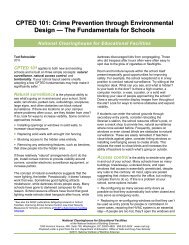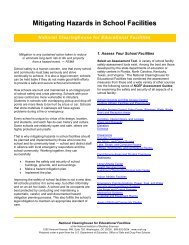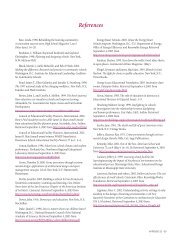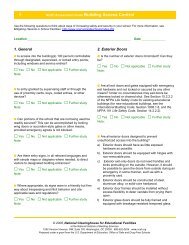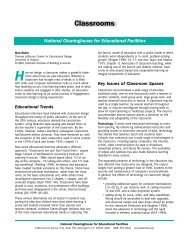- Page 2: EDUCATIONAL FACILITIES DISASTER AND
- Page 5 and 6: TABLE OF CONTENTS MITIGATION Mitiga
- Page 8 and 9: INTRODUCTION Purpose The goal of th
- Page 10 and 11: INTRODUCTION # A mechanism for dire
- Page 12 and 13: INTRODUCTION Disasters and Catastro
- Page 14 and 15: INTRODUCTION In the event of a thun
- Page 16 and 17: INTRODUCTION Develop a policy for s
- Page 18 and 19: INTRODUCTION # Stay tuned to local
- Page 20 and 21: INTRODUCTION # Develop a plan that
- Page 22 and 23: INTRODUCTION U.S. National Elevator
- Page 24 and 25: INTRODUCTION Epidemic and Pandemic
- Page 26 and 27: INTRODUCTION As a facility manager,
- Page 30 and 31: INTRODUCTION Lockdown A school lock
- Page 32: PREPAREDNESS - Preparedness - Schoo
- Page 35 and 36: PREPAREDNESS School Disaster Plan A
- Page 37 and 38: PREPAREDNESS Facility Preparedness
- Page 39 and 40: PREPAREDNESS facilities project man
- Page 41 and 42: PREPAREDNESS Go Kits “In 2005, th
- Page 43 and 44: PREPAREDNESS It is also helpful to
- Page 45 and 46: PREPAREDNESS that the person who kn
- Page 47 and 48: PREPAREDNESS Designated Command Pos
- Page 49 and 50: PREPAREDNESS of release forms (enou
- Page 51 and 52: PREPAREDNESS Whichever methods you
- Page 53 and 54: PREPAREDNESS 48
- Page 56 and 57: RESPONSE Response Response to a dis
- Page 58 and 59: RESPONSE The Incident Command Syste
- Page 60 and 61: RESPONSE Unified Command Although a
- Page 62 and 63: RESPONSE Command Center Establish a
- Page 64 and 65: RESPONSE Emergency Operations Cente
- Page 66 and 67: RESPONSE Shelters Types of hurrican
- Page 68 and 69: RESPONSE Host Shelters Host Shelter
- Page 70 and 71: RESPONSE Shelter Considerations Sho
- Page 72 and 73: RESPONSE # Develop procedures to fo
- Page 74: RECOVERY - Recovery - Initial Site
- Page 77 and 78: RECOVERY Initial Site Inspection an
- Page 79 and 80:
RECOVERY # Labs, Shops, Computer Ro
- Page 81 and 82:
RECOVERY Infrared photography can a
- Page 83 and 84:
RECOVERY Insurance and Pitfalls Boa
- Page 85 and 86:
RECOVERY # Wind and storm coverage.
- Page 87 and 88:
RECOVERY Submission of invoices sho
- Page 89 and 90:
RECOVERY 84
- Page 91 and 92:
RECOVERY FEMA Public Assistance Pro
- Page 93 and 94:
RECOVERY Eligibility Following the
- Page 95 and 96:
RECOVERY Negligence Damage caused b
- Page 97 and 98:
RECOVERY An applicant may not recei
- Page 99 and 100:
RECOVERY Contracts Contracts must b
- Page 101 and 102:
RECOVERY Category Type of Work Emer
- Page 103 and 104:
RECOVERY # Function: The facility m
- Page 105 and 106:
RECOVERY # 9570.2 Public Assistance
- Page 107 and 108:
RECOVERY the Stafford Act and elabo
- Page 109 and 110:
RECOVERY assistance. There are two
- Page 111 and 112:
106
- Page 113 and 114:
MITIGATION The first step in formul
- Page 115 and 116:
MITIGATION # Measures must comply w
- Page 117 and 118:
MITIGATION # FEMA: » Secondary ins
- Page 119 and 120:
MITIGATION 114
- Page 121 and 122:
116
- Page 123 and 124:
CLOSING 118
- Page 125 and 126:
BIBLIOGRAPHY Emergency Procedures M
- Page 127 and 128:
BIBLIOGRAPHY State of Florida Disas
- Page 129 and 130:
BIBLIOGRAPHY Volusia County School
- Page 131 and 132:
126
- Page 133 and 134:
located to serve as such shelters.
- Page 135 and 136:
The selection of an appropriate des
- Page 137 and 138:
Table F-1. Summary of EHPA Wind Des
- Page 139 and 140:
Disaster Services volunteers to rem
- Page 141 and 142:
e. Anger outbursts and/or aggressio
- Page 143 and 144:
138
- Page 145 and 146:
· Each district must also establis
- Page 147 and 148:
Phase II: Public Rights-of-Way Debr
- Page 149 and 150:
Private Property Demolition and Deb
- Page 151 and 152:
Program Description Materials Gener
- Page 153 and 154:
Drop-off Fencing Ghost Town Residen
- Page 155 and 156:
A jurisdiction can take advantage o
- Page 157 and 158:
Identify labor needs Estimate staff
- Page 159 and 160:
Hammermill Stump Grinder Rotary She
- Page 161 and 162:
Processing techniques - wood, concr
- Page 163 and 164:
professionals. Where assembling suc
- Page 165 and 166:
Anderson, Inc, Architects, and Jose
- Page 167 and 168:
Management - Overall policy directi
- Page 169 and 170:
# Monitor check-in sheets daily to
- Page 171 and 172:
166
- Page 173 and 174:
168
- Page 175 and 176:
ICS 214 170
- Page 177 and 178:
# Complete change of clothing inclu
- Page 179 and 180:
174
- Page 181 and 182:
Tool Kit Supplies: • Flashlight.
- Page 183 and 184:
Photo 4 Photo Documenting Roof Flas
- Page 185 and 186:
sections on this form. The top righ
- Page 187 and 188:
182
- Page 189 and 190:
184
- Page 191 and 192:
FORM 2B PRE-STORM CHECKLIST ITEM LO
- Page 193 and 194:
FORM 3B GROUNDS DAMAGE ASSESSMENT E
- Page 195 and 196:
190
- Page 197 and 198:
FORM 5B CONTENT DAMAGE ASSESSMENT [
- Page 199 and 200:
194
- Page 201 and 202:
196
- Page 203 and 204:
198
- Page 205 and 206:
July 31, 2000 F. The existence in t
- Page 207 and 208:
July 31, 2000 Fla. Stat. (1999), or
- Page 209 and 210:
July 31, 2000 accordance with the C
- Page 211 and 212:
July 31, 2000 C. An estimate of the
- Page 213 and 214:
July 31, 2000 B. An assisting Party
- Page 215 and 216:
July 31, 2000 ARTICLE VIII. Cost El
- Page 217 and 218:
July 31, 2000 D. The Assisting Part
- Page 219 and 220:
July 31, 2000 Party under this Agre
- Page 221 and 222:
July 31, 2000 D. Unless superseded
- Page 223 and 224:
July 31, 2000 IN WITNESS WHEREOF, t
- Page 225 and 226:
July 31, 2000 DIVISION OF EMERGENCY
- Page 227 and 228:
July 31, 2000 STATEWIDE MUTUAL AID
- Page 229 and 230:
July 31, 2000 STATEWIDE MUTUAL AID
- Page 231 and 232:
226



